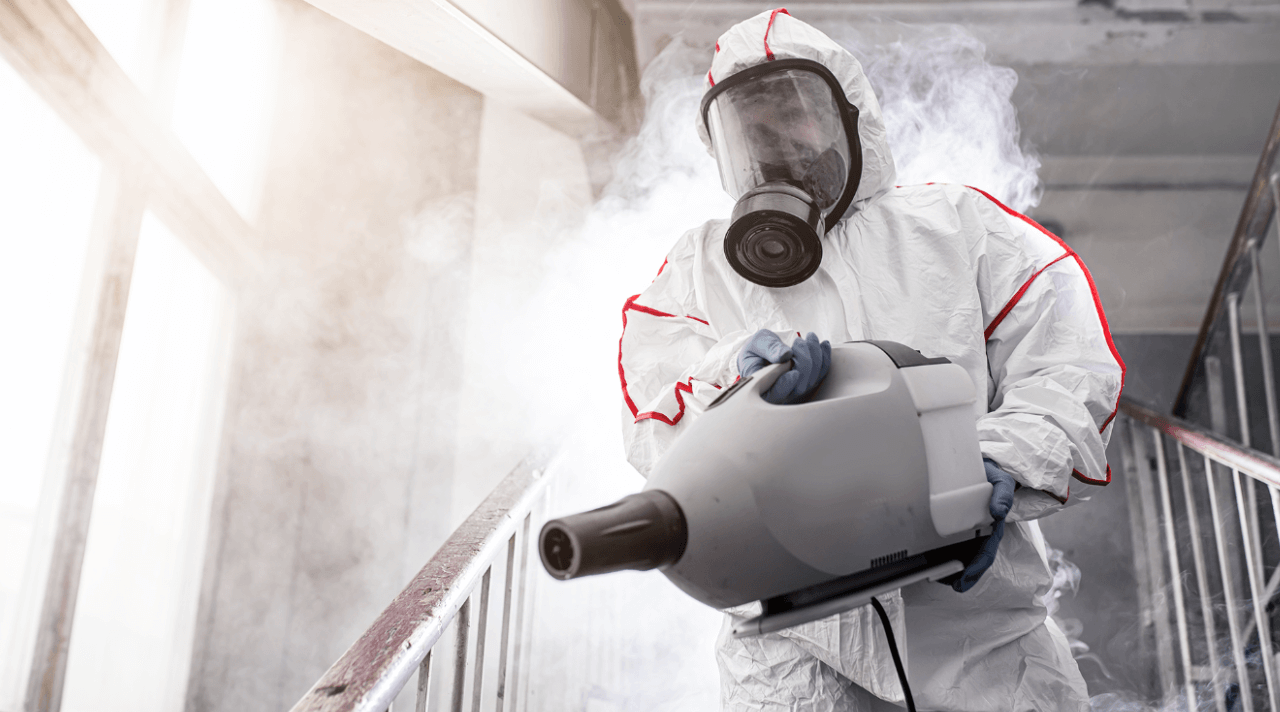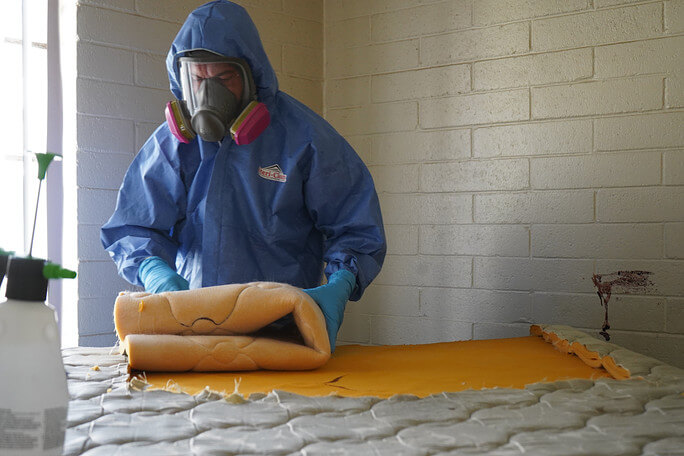Sewage Cleanup Providers: Rapid and Safe Remediation of Contaminated Locations
Sewage Cleanup Providers: Rapid and Safe Remediation of Contaminated Locations
Blog Article
Expert Biohazard Cleansing and Purification for Blood, Bodily Fluids, and Hazardous Products
In the world of biohazard cleansing and purification for blood, physical liquids, and unsafe products, accuracy and expertise are paramount. The possible wellness risks connected with exposure to biohazards emphasize the important demand for careful handling and complete cleaning. Specialized training equips experts with the understanding and skills essential to address these unsafe circumstances successfully. Nevertheless, it is not merely about cleansing up; the relevance of using appropriate purification methods can not be overstated. As we browse the complex landscape of biohazard cleanup, recognizing the nuances of regulations, conformity, and the specialized tools at play ends up being important in ensuring a secure and extensive decontamination procedure.
Health And Wellness Threats of Biohazard Exposure
Exposure to biohazards positions substantial wellness risks that can lead to serious effects for neighborhoods and people alike. Biohazards incorporate a vast array of biological compounds, consisting of blood, physical liquids, mold and mildew, bacteria, viruses, and other potentially contagious products. When people enter call with these biohazards, whether via crashes, improper handling, or environmental exposure, they face the risk of contracting major health problems or conditions.
Among the key wellness threats linked with biohazard direct exposure is the transmission of infectious conditions. Bloodborne virus such as HIV, liver disease B and C, and numerous microorganisms can be existing in biohazardous materials, posing a direct threat to human health. Breathing in air-borne biohazards like mold and mildew spores or entering into call with infected surface areas can likewise result in respiratory issues, allergies, and other adverse wellness results.
Moreover, biohazard exposure can have long-lasting health implications, with some conditions showing up years after the preliminary get in touch with (Blood Cleanup). For that reason, it is essential to prioritize correct biohazard cleansing and decontamination to mitigate these wellness dangers and guarantee the safety of neighborhoods and people

Specialized Training for Biohazard Cleaning
When it concerns taking care of biohazard cleanup successfully and securely, specialized training plays an essential duty in guaranteeing correct decontamination treatments are adhered to. Biohazard clean-up calls for specific understanding and abilities to effectively alleviate threats connected with bloodborne microorganisms, physical liquids, and dangerous products. Specialists educated in biohazard cleanup go through strenuous instruction on exactly how to securely handle, eliminate, and dispose of biohazardous materials to avoid contamination and exposure.
Specialized training for biohazard cleanup covers a variety of necessary subjects, including proper individual safety equipment (PPE) usage, bloodborne virus understanding, decontamination strategies, and contaminated materials disposal methods. Individuals educated in biohazard clean-up are equipped with the needed expertise to evaluate contamination degrees, recognize prospective risks, and apply proper clean-up procedures in conformity with regulatory criteria.
Continual training and education are extremely important in the field of biohazard cleaning to remain upgraded on the current decontamination innovations, safety methods, and policies. By investing in specialized training, biohazard cleaning professionals can properly reply to emergency clean-up circumstances and safeguard both public health you can try this out and wellness and the setting.
Relevance of Proper Decontamination Strategies
Making use of proper purification methods is essential in biohazard clean-up to properly eliminate dangerous materials and lessen wellness dangers. Effective purification not only makes sure the elimination of noticeable traces of blood, bodily liquids, and other biohazards yet additionally targets undetectable microorganisms that might present severe health and wellness risks otherwise appropriately eradicated. By adhering to stringent purification protocols, educated specialists can substantially reduce the danger of direct exposure to harmful microbes, viruses, and microorganisms that could cause illness or infections.
Correct decontamination methods entail a fantastic read the use of specific tools and disinfectants that are particularly made to neutralize biohazards successfully. Comprehensive cleansing and sanitation of contaminated areas are important to protect against the spread of virus and ensure a risk-free setting for owners. Additionally, the appropriate disposal of biohazardous waste complying with purification treatments is vital in avoiding contamination of various other surface areas or people.

Tools and Devices for Safe Clean-up
When dealing with blood, bodily liquids, or hazardous products, biohazard cleaning experts count on specialized gear to decrease exposure threats and thoroughly sanitize the affected area. In addition, biohazard cleaning packages containing anti-bacterials, absorbing materials, and biohazard bags are made use of to safely dispose and consist of of infected items.
Advanced cleansing devices like hospital-grade disinfectants, HEPA-filtered vacuums, and misting machines are utilized to disinfect surface areas and remove biohazards successfully. Specialized tools such as sharps containers and biohazard waste disposal bins are made use of to securely manage sharp items and biohazardous waste products. By making use of the right equipment and tools, biohazard cleansing specialists can ensure a complete cleaning procedure that prioritizes safety and reduces health and wellness threats for both employees and occupants of the affected area.
Regulations and Compliance in Biohazard Cleaning
Appropriate adherence to guidelines and conformity criteria is paramount in biohazard cleaning to ensure the safety of both personnel and the environment. Government agencies such as OSHA (Occupational Safety and Health And Wellness Administration) and the EPA (Environmental Security Company) have established particular guidelines for biohazard cleanup procedures to minimize health threats and ecological contamination. special info These laws cover a variety of facets consisting of the handling, transport, and disposal of biohazardous materials, as well as the necessary training and protective tools needed for workers associated with the cleanup process.
Biohazard cleansing firms need to stay up-to-date with these regulations to guarantee that their procedures satisfy the needed security standards. Failure to follow these laws can cause serious consequences, consisting of penalties, lawsuit, and jeopardizing the health and wellness of individuals and the setting. By complying with strict regulations and conformity procedures, biohazard cleaning companies can properly minimize dangers and guarantee a complete and risk-free clean-up process for all events included.
Conclusion
In conclusion, biohazard cleansing and decontamination call for specific training, proper strategies, and adherence to policies. Direct exposure to blood, bodily liquids, and dangerous products poses substantial health dangers, making it crucial to utilize the best tools and tools for risk-free cleanup. By complying with rigorous protocols and standards, professionals can efficiently minimize the dangers connected with biohazard direct exposure and guarantee the security of both themselves and others.
As we browse the elaborate landscape of biohazard clean-up, recognizing the nuances of policies, conformity, and the customized equipment at play comes to be crucial in ensuring a risk-free and complete purification procedure. (Blood Cleanup)
When it comes to taking care of biohazard cleanup effectively and securely, specialized training plays a basic role in ensuring appropriate decontamination treatments are adhered to.Utilizing correct purification methods is essential in biohazard cleaning to properly eliminate unsafe materials and minimize health risks. Additionally, biohazard cleaning packages containing anti-bacterials, absorbing materials, and biohazard bags are used to securely contain and get rid of of polluted products.
Government agencies such as OSHA (Occupational Safety And Security and Wellness Management) and the EPA (Environmental Security Agency) have developed certain guidelines for biohazard clean-up procedures to decrease wellness dangers and environmental contamination.
Report this page